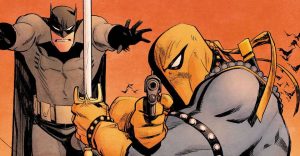Da 5 Bloods True Story: How Much Of Spike Lee’s Vietnam Movie Was Real

Spike Lee’s new Netflix film Da 5 Bloods may be a fictional tale, but it draws on real-life experiences of black soldiers in the Vietnam War and references key events of the time. The story follows four black Vietnam War vets – Paul (Delroy Lindo), Otis (Clarke Peters), Melvin (Isiah Whitlock Jr.) and Eddie (Norm Lewis) – as they return to Vietnam in modern times to retrieve a lost stash of gold, along with the body of their late comrade, Stormin’ Norman (Chadwick Boseman).
One of the main sources used for Da 5 Bloods is a book called Bloods: An Oral History of the Vietnam War by author Wallace Terry, which offers the perspective of black soldiers during the war. The book features accounts from twenty different black veterans, detailing the particular hardships they faced as a result of their race during their service in Vietnam, and their conflicted feelings about the war and America’s reasons for being there.
Da 5 Bloods features an opening montage of major historical events leading up to and during the Vietnam War, both overseas and at home, and also features footage and photos at key moments throughout the rest of the film. The fictional story is closely intertwined with the realities of the Vietnam War, so here’s what’s real and what’s not in Da 5 Bloods.
Was Da 5 Bloods Gold Real?

The story behind the gold in Da 5 Bloods is that the CIA was secretly flying a plane full of gold intended for a group of native Vietnamese people called the Lahu, who were helping to fight the Vietcong. Otis explains that they didn’t want to be paid in paper currency, and instead asked for the gold bars. While there’s no evidence of the CIA flying gold bars out to Vietnam as payment for tribespeople, there is truth to Otis’ story of the Lahu people aiding the U.S. during the war. Referred to as the U.S. Secret Army, the Lahu – along with other tribes like the Hmong, Lao, and Mien – were recruited by the CIA to disrupt Communist supply lines, guide bombing operations, and rescue downed U.S. pilots. After the war, many of the Lahu were forced to flee to Thailand in order to escape retribution from the new government.
The Black Soldier Experience Of The Vietnam War

Though enlisting in the army was promoted as a way for black men to become part of a more equal culture full of opportunity, racism was as pervasive among the troops in Vietnam as it was back home. Following the assassination of Martin Luther King, crosses were burned at Cam Ranh Bay and Confederate flags were flown over bases in Danang. According to U.S. Congress Records, latrines and bars in Vietnam had graffiti scrawled on them with sentiments like “N****rs eat s**t” and “I’d prefer a g**k to a n****r,” and there were many incidents of violence between black and white soldiers. As is noted in Da 5 Bloods, black soldiers were rarely promoted, were generally segregated from white soldiers when not in the field, and were tasked with more dangerous assignments.
This was far from the first American war that black soldiers had been instrumental in fighting. The 369th Infantry Regiment, better known as the Harlem Hellfighters, became legends of World War I, serving longer on the front lines than any other unit despite receiving less training, and experiencing more losses than any other regiment. But during the Vietnam War, anger and resentment over the treatment of black soldiers started to boil over in a way that it hadn’t before. Major Wardell C. Smith observed that:
“When I came into the army in 1956, everything was quiet. No one was raising any hell about the prejudice and discrimination that was going on. The Negro soldier didn’t know which way to go as far as speaking out against it. Every time he tried to, he got kicked in the head. Now they can speak and somebody will listen. And some feel that since they are going to face death, it doesn’t matter what happens.”
Speaking to TIME magazine in 1969, a black soldier characterized the resentment and lack of morale among black troops in Vietnam by asking, “Why should I come over here when some of the South Vietnamese live better than my people?… We have enough problems fighting white people back home.” Indeed, much of the disquiet among soldiers in Vietnam was influenced by major events in the fight for civil rights back home, and Da 5 Bloods uses real photos and footage of those moments to capture the mood of the time.
Real Life Events Referenced In Da 5 Bloods

- 11 June 1963 – Self-Immolation of Thích Quảng Đức – As the centerpiece of a protest organized by Buddhist monks against the persecution of Buddhists in South Vietnam, a 65 year-old monk called Thích Quảng Đức sat down at a busy Saigon intersection and set a match to his petrol-soaked robes, burning himself to death. Da 5 Bloods uses the Pulitzer Prize-winning photo of his death, and video footage of a similar self-immolation by Buddhist monk Ho Dinh Van on October 27 1963.
- February 1st 1968 – Nguyễn Văn Lém Execution – In a gruesome scene documented by a NBC cameraman and an Associated Press photographer, South Vietnamese General Nguyễn Ngọc Loan summarily executed a Vietcong prisoner called Nguyễn Văn Lém who had just been captured, by shooting him in the head.
- 16 March 1968 – My Lai Massacre – In one of the most horrific acts ever perpetrated by the U.S. military, more than 500 Vietnamese civilians were rounded up and slaughtered by American troops in the village of My Lai. The women and girls were raped and some of the bodies were mutilated. Only one of the perpetrators was ever convicted: Lieutenant William Cally, whose name Quân (Lam Nguyen) throws at Paul during the confrontation with the Bloods. Though he initially received a life sentence, Cally served just three and a half years on house arrest.
- August 1968 – Democratic National Convention Protests – For eight days leading up to and during the 1968 DNC, antiwar activists staged protests in Chicago, Illinois. The clashes with police led to hundreds of injuries.
- October 16 1968 – Mexico City Olympics – Olympic gold medallist Tommie Smith and bronze medallist John Carlos each raised a black-gloved fist, symbolizing the Black Power movement, as “The Star-Spangled Banner” played during their medal ceremony. They were both expelled from the Games for their silent protest.
- July 1969 – Apollo 11 Mission – The first successful manned mission to the moon was also a lightning rod for civil rights protests. More than 500 protesters amassed outside the Kennedy Space Center, led by civil rights leader Ralph Abernathy. In Da 5 Bloods‘ opening montage, Abernathy is seen holding a sign saying “$12 a day to feed an astronaut. We could feed a starving child for $8.”
- May 4 1970 – Kent State Shootings – During an antiwar peace rally protesting America’s involvement in the Vietnam conflict at Kent State University, 13 students were shot by the Ohio National Guard in a hail of bullets. Four students were killed and nine were injured.
- May 15th, 1970 – Jackson State Shootings – 11 days after the Kent State shootings there was a similar attack at Jackson State College, a historically black university, where two students were killed and 12 more injured when police fired on protesters.
- June 8th 1972 – Napalm Bombing Of Children – A Pulitzer Prize-winning photo of nine year-old Phan Thi Kim Phuc, better known as “Napalm girl,” was taken after South Vietnamese forces dropped napalm bombs on the village of Trảng Bàng.
- April 29th 1975 – Fall Of Saigon – The Vietnam War ended with the Fall of Saigon, in which the Vietcong and the People’s Army of North Vietnam captured Saigon, the capital of South Vietnam. Archive footage in Da 5 Bloods shows a helicopter on the USS Midway being pushed into the ocean to make room for incoming aircraft carrying evacuating South Vietnam military.
Hanoi Hannah’s Radio Broadcasts

One slice of Vietnam War life featured in Da 5 Bloods is the radio broadcasts by Trinh Thi Ngo, better known by the nickname Hanoi Hannah or the alias Thu Hu’o’ng (“fragrance of autumn“). For eight years during the American occupation of Vietnam, Hanoi Hannah read propaganda scripts on Radio Hanoi that were designed to instil resentment and hopelessness in American troops – not by insulting them, but criticizing their leaders and inviting them to question why they were there. “My goal was to tell GIs they shouldn’t participate in a war that wasn’t theirs,” Ngo recalled in a 1998 interview with the LA Times. “I tried to be friendly and convincing. I didn’t want to be shrill or aggressive. For instance, I referred to the Americans as the adversary. I never called them the enemy.”
In addition to playing American antiwar records like “Where Have All the Flowers Gone” and reading statements questioning the GIs’ motivations to continue fighting, she would also read out the names of American soldiers who had been killed in a segment called “Those who die but not for glory.” In Da 5 Bloods, four of the Bloods are motivated by one of Hanoi Hannah’s broadcasts to find some white people to kill, until their tempers are calmed by Norman. In reality, there’s little evidence to suggest that Hanoi Hannah convinced many, if any, American soldiers to desert. However, she did become something of a celebrity among GIs, who would listen to her broadcasts attentively. Ngo retired from radio after the war and lived a quiet life afterwards, finally passing away in 2016 at the age of 85.
Was David Escaping The Land Mine Realistic?

At one point in Da 5 Bloods, Paul’s son David (Jonathan Majors) finds himself in an extremely dangerous position when he steps on a land mine. As unrealistic as the scene might appear, the incident that Paul uses to strategize David’s escape is actually based on a real story (though not necessarily a true one). The story is recounted in Bloods by Harold “Light Bulb” Bryant, who says that he was once called in to help a white soldier who had stepped on a land mine.
As the story goes, the soldier had been standing on the landmine, being extremely careful not to shift his weight, for over an hour by the time Bryant arrived. After digging around the mine, Bryant discovered that it was a German S-Mine, better known as a “Bouncing Betty.” At first he attempted an Indiana Jones-esque maneuver of having the soldier take his foot out of the boot while Bryant held the boot down to maintain the pressure, but he quickly aborted that plan when he saw the plunger starting to rise. By this time, another hour had passed. Finally, Bryant says, he came up with the rope plan:
“Then I got the idea. I knew when the plunger would depress, the Bouncin’ Betty would bounce up about 3 feet and then explode. So I got the other members of his team together, and I tied a rope around his waist. And everybody, including me, moved off about 20 yards from the mine and him. And when I counted to three, everyone would pull on the rope and snatch him about 15 feet off the mine. And it would bounce up its 3 feet and explode. And it did that. And the only damage that he received was the heel of his jungle boot that was blown off. No damage to him.”
It’s an incredible story, and therefore one that has drawn a lot of incredulity. According to Slate, the veracity of Bryant’s claim has been questioned due to the fact that the mine story was apparently a known urban legend, with others claiming that it had happened to them instead. Bryant also allegedly may have exaggerated his service record. The story is particularly hard to believe since it doesn’t tally with how the Bouncing Betty mine actually works. Though stepping on the pressure plate of a mine and finding a way to escape is a common movie trope, in reality landmines are designed to explode as soon as pressure is applied, not once it’s removed. Moreover, the S-Mine works by “bouncing” up into the air and then exploding, spraying shrapnel horizontally all around the area, so it’s extremely unlikely that David could have escaped unscathed by jumping sideways.
Vietnamese-American Children

Early on in Da 5 Bloods, Otis learns that he had an adult daughter with his old flame, Tiên (Lê Y Lan). Otis and Tiên’s daughter, Michon (Sandy Huong Pham) appears to have been more fortunate than most children of Vietnamese mothers and American soldiers that were conceived during the war. According to Smithsonian Magazine, the U.S. government initially washed its hands of all responsibility for the children, while the Vietnamese director of social care described them as “bad elements.” As babies many of them were abandoned in garbage cans and outside orphanages, and as children they were bullied for their mixed-race appearance.
It’s unknown exactly how many Amerasians were born during and after the Vietnam War, since many of their births went unregistered. However, in 1987 Congress passed the Amerasian Homecoming Act, which allowed Vietnamese children of American soldiers to immigrate to the United States. Around 26,000 of these children and 75,000 of their Vietnamese relatives resettled in the U.S., and according to advocacy groups Amerasian Independent Voice of America and the Amerasian Fellowship Association (via Smithsonian Magazine), only a few hundred Amerasians from the Vietnam War are now left in Vietnam. It is believed that no more than 3% of these children were ever reunited with their American fathers.
About The Author
















